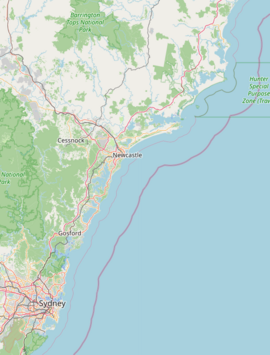Teralba, New South Wales facts for kids
Quick facts for kids TeralbaGreater Newcastle, New South Wales |
|||||||||||||||
|---|---|---|---|---|---|---|---|---|---|---|---|---|---|---|---|
| Population | 2,652 (2021 census) | ||||||||||||||
| • Density | 603/km2 (1,560/sq mi) | ||||||||||||||
| Established | 1831 | ||||||||||||||
| Postcode(s) | 2284 | ||||||||||||||
| Area | 4.4 km2 (1.7 sq mi) | ||||||||||||||
| Location | |||||||||||||||
| LGA(s) | City of Lake Macquarie | ||||||||||||||
| Parish | Teralba | ||||||||||||||
| State electorate(s) | Lake Macquarie | ||||||||||||||
| Federal Division(s) | Hunter | ||||||||||||||
|
|||||||||||||||
Teralba is a small town and suburb in New South Wales, Australia. It's part of Greater Newcastle and the City of Lake Macquarie. You can find it on the northern shore of Lake Macquarie, between Speers Point and Booragul. Teralba started to grow in the early 1880s. This was when the railway line from Homebush to Waratah was being built.
Contents
Teralba's Past
Early Days and First People
The Awabakal people are the original owners of the land where Teralba is located. They have lived here for a very long time.
In the early days, Teralba had many different jobs. People worked in coal mining and gravel quarries. There were also market gardens, where fresh food was grown. The Teralba Railway Station first opened its doors in 1887. The very first meeting of the Lake Macquarie Shire Council happened in the Teralba Court House in 1906.
Coal Mining History
In the 1880s, a company called the Great Northern Coal Company started. They leased a large area of land for mining. This mine later became known as the Pacific Colliery in 1914.
Teralba Public School
Teralba Public School opened in 1884. A special school bell was used there since the late 1800s. Sadly, this bell was stolen in 2018. It was part of a memorial garden for Kevin Lester Peterson. Mr. Peterson was the school's principal from 1974 to 1986. He also organized the school's 100-year celebration in 1984.
Local Landmarks and Names
The hill to the south of Teralba is called Billy Goat Hill. An area around Victoria Street was known as Monkey Town until the 1940s. People say this was because a local person had a pet monkey. The area near Rhondda Road was once called the "Gravel Pits."
Important Buildings
Teralba has some interesting old buildings. One is the old mine manager's home on Rodgers Street. Another is a large house on Railway Street. It has the initials "AS" on it, for Andrew Sneddon. He was a local who died in World War I. The main building of Teralba Public School was built in 1898. It was made for the Teralba Colliery. On the waterfront, there's a large brick building. It used to be a timber hotel called The Lake Macquarie Hotel. It was changed into flats in 1972.
Old Cemetery
The original Teralba graveyard is now in Booragul. It is on Billy Goat Hill, near the railway station. Important local people were buried there. This includes James Cherry, who died in an accident at Teralba Colliery. Cherry's Bridge at Barnsley is named after his family. Very little of the cemetery remains today.
Roads and Bridges
Teralba's main road was once the main route from Toronto to Newcastle. The original Watkins Bridge was made of timber. It crossed Cockle Creek from Race Course Road to Boolaroo. Some parts of the old bridge can still be seen. The name Watkins is now only used for a small bridge near Blair Street. It is also used for Watkins Lane off Railway Street.
Race Course Road got its name from a race course. This race course was once located near the weir on the way to Barnsley. A famous aviator, Kingsford Smith, made an emergency landing there. The first person to help him was a local boy named Ernest Eade.
The Weir and Power Station
A weir was built between Teralba and Barnsley over Cockle Creek. This happened in the 1920s. It was built to help the Cockle Creek Power Station. The power station gave electricity to Teralba and nearby towns. These towns included Barnsley, Estelville (now Cameron Park), Wakefield, West Wallsend, and Killingworth. The power station closed in 1976. Today, only the weir and the old mine manager's home remain. The power station itself was on the Teralba side of the creek.
The power station got its coal from the Rhondda coal mine. The coal came by train. The railway tracks have been removed. The old trains were taken away in the 1980s. However, the bridge for the railway still exists. You can follow the old track from the waste treatment plant. This plant is all that remains of Rhondda. The town was taken down in the 1950s after the mine closed. Be careful if you explore this area. It can be dangerous due to old mine tunnels collapsing.


